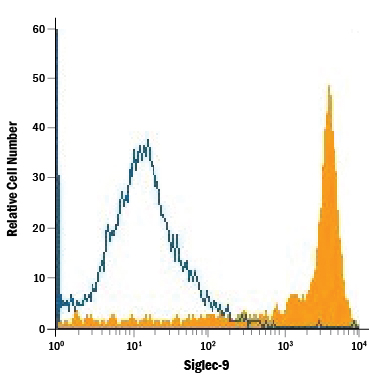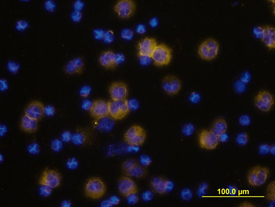Human Siglec-9 Biotinylated Antibody Summary
Gln18-Gly348
Accession # Q9Y336
Applications
Human Siglec-9 Sandwich Immunoassay
Please Note: Optimal dilutions should be determined by each laboratory for each application. General Protocols are available in the Technical Information section on our website.
Scientific Data
 View Larger
View Larger
Detection of Siglec‑9 in Human Monocytes by Flow Cytometry. Human peripheral blood monocytes were stained with Goat Anti-Human Siglec-9 Biotinylated Antigen Affinity-purified Polyclonal Antibody (Catalog # BAF1139, filled histogram) or isotype control antibody (Catalog # BAF108, open histogram), followed by Streptavidin-Phycoerythrin (Catalog # F0040).
 View Larger
View Larger
Siglec‑9 in Human PBMCs. Siglec-9 was detected in immersion fixed human peripheral blood mononuclear cells (PBMCs) using Goat Anti-Human Siglec-9 Biotinylated Antigen Affinity-purified Polyclonal Antibody (Catalog # BAF1139) at 10 µg/mL for 3 hours at room temperature. Cells were stained using the NorthernLights™ 557-conjugated Streptavidin (yellow; Catalog # NL999) and counterstained with DAPI (blue). View our protocol for Fluorescent ICC Staining of Non-adherent Cells.
Reconstitution Calculator
Preparation and Storage
- 12 months from date of receipt, -20 to -70 °C as supplied.
- 1 month, 2 to 8 °C under sterile conditions after reconstitution.
- 6 months, -20 to -70 °C under sterile conditions after reconstitution.
Background: Siglec-9
Siglecs(1) (sialic acid binding Ig-like lectins) are I-type (Ig-type) lectins belonging to the Ig superfamily. They are characterized by an N-terminal Ig-like V-type domain which mediates sialic acid binding, followed by varying numbers of Ig-like C2-type domains (1, 2). Eleven human Siglecs have been cloned and characterized. They are sialoadhesin/CD169/Siglec-1, CD22/Siglec-2, CD33/Siglec-3, Myelin-Associated Glycoprotein (MAG/Siglec-4a) and Siglec-5 to -11 (1‑4). To date, no Siglec has been shown to recognized any cell surface ligand other than sialic acids, suggesting that interactions with glycans containing this carbohydrate are important in mediating the biological functions of Siglecs. Siglecs 5 to 11 share a high degree of sequence similarity with CD33/Siglec-3 both in their extracellular and intracellular regions. They are collectively referred to as CD33-related Siglecs. One remarkable feature of the CD33-related Siglecs is their differential expression pattern within the hematopoietic system (2, 3). This fact, together with the presence of two conserved immunoreceptor tyrosine-based inhibition motifs (ITIMs) in their cytoplasmic tails, suggests that CD33-related Siglecs are involved in the regulation of cellular activation within the immune system.
The cDNA of human Siglec-9 encodes a 463 amino acid (aa) polypeptide with a hydrophobic signal peptide, an N-terminal Ig-likeV-type domain, two Ig-like C2-type domains, a transmembrane region and a cytoplasmic tail (5, 6). In peripheral blood leukocytes, Siglec-9 is expressed on neutrophils, monocytes, a fraction of NK cells, B cells, and a minor subset of CD8+ T cells (5). It binds equally well to both 2,3- and 2,6-linked sialic acid (5, 6). Siglec-9 is closely related to Siglec-7, and they share ~80% amino acid sequence identity. The gene encoding siglec-9 was mapped to chromosome 19q13.4.
- Crocker, P.R. et al. (1998) Glycobiology 8:v.
- Crocker, P.R. and A. Varki (2001) Trends Immunol. 22:337.
- Crocker, P.R. and A. Varki (2001) Immunology 103:137.
- Angata, T. et al. (2002) J. Biol. Chem. 277:24466.
- Zhang, J.Q. et al. (2000) J. Biol. Chem. 275:22121.
- Angata, T. et al. (2000) J. Biol. Chem. 275:22127.
Product Datasheets
Citations for Human Siglec-9 Biotinylated Antibody
R&D Systems personnel manually curate a database that contains references using R&D Systems products. The data collected includes not only links to publications in PubMed, but also provides information about sample types, species, and experimental conditions.
2
Citations: Showing 1 - 2
Filter your results:
Filter by:
-
Siglec-9 defines and restrains a natural killer subpopulation highly cytotoxic to HIV-infected cells
Authors: OS Adeniji, L Kuri-Cerva, C Yu, Z Xu, M Ho, GM Chew, C Shikuma, C Tomescu, AF George, NR Roan, LC Ndhlovu, Q Liu, K Muthumani, DB Weiner, MR Betts, H Xiao, M Abdel-Mohs
PloS Pathogens, 2021-11-11;17(11):e1010034.
Species: Human
Sample Types: Whole Cells
Applications: Depletion -
Siglecs facilitate HIV-1 infection of macrophages through adhesion with viral sialic acids.
Authors: Zou Z, Chastain A, Moir S
PLoS ONE, 2011-09-08;6(9):e24559.
Species: Human
Sample Types: Whole Cells
Applications: Flow Cytometry
FAQs
No product specific FAQs exist for this product, however you may
View all Antibody FAQsReviews for Human Siglec-9 Biotinylated Antibody
There are currently no reviews for this product. Be the first to review Human Siglec-9 Biotinylated Antibody and earn rewards!
Have you used Human Siglec-9 Biotinylated Antibody?
Submit a review and receive an Amazon gift card.
$25/€18/£15/$25CAN/¥75 Yuan/¥2500 Yen for a review with an image
$10/€7/£6/$10 CAD/¥70 Yuan/¥1110 Yen for a review without an image

